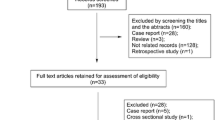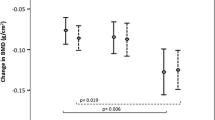Abstract
Summary
This study systematically reviews prospective cohort studies evaluating the relationship between C-reactive protein (CRP) concentrations and subsequent fracture risk. The positive association cannot completely explain the existing evidence, and further studies are needed to demonstrate the shape of the association.
Introduction
We aimed to perform a systematic review and dose–response meta-analysis of published prospective studies evaluating associations of high-sensitivity CRP (hs-CRP) levels with fracture risk in general populations.
Methods
We identified relevant studies by searching MEDLINE and EMBASE databases from their inception to May 20, 2014. We included published prospective studies evaluating the associations of hs-CRP levels with risk of fracture in general populations. Two reviewers working independently abstracted the data.
Results
Eight prospective cohort studies involving 34,840 participants and 3,407 incident fracture events were eligible for the present analyses. A meta-analysis of six prospective studies showed that the overall risk for incident fracture in a comparison of individuals in the top tertile with those in the bottom tertile of baseline hs-CRP levels was 2.14 [95 % confidence interval (CI) 1.51–3.05, I 2 = 62.3 %]. The moderate heterogeneous disappeared when one study was excluded. However, the remaining two studies reported inconsistent results. One study with the biggest sample size showed a U-shaped association for CRP and fracture risk (the association was positive when CRP > 1 mg/L). Similarly, another study reported that per doubling of CRP was positive only when CRP > 3 mg/L.
Conclusion
In summary, the present analysis showed that the relationship between CRP concentrations and subsequent fracture risk is still inconsistent. The positive association cannot completely explain the existing evidence, and further larger prospective cohorts with more power are needed to demonstrate the shape of the association, especially for the relatively low CRP concentrations, such as less than 3 mg/L.



Similar content being viewed by others
References
Khosla S, Amin S, Orwoll E (2008) Osteoporosis in men. Endocr Rev 29(4):441–464
Bernstein CN, Blanchard JF, Leslie W, Wajda A, Yu BN (2000) The incidence of fracture among patients with inflammatory bowel disease. A population-based cohort study. Ann Intern Med 133(10):795–799
Walsh NC, Crotti TN, Goldring SR, Gravallese EM (2005) Rheumatic diseases: the effects of inflammation on bone. Immunol Rev 208:228–251
Lane NE (2006) Therapy insight: osteoporosis and osteonecrosis in systemic lupus erythematosus. Nat Clin Pract Rheumatol 2(10):562–569
Lacativa PG, Farias ML (2010) Osteoporosis and inflammation. Arq Bras Endocrinol Metabologia 54(2):123–132
Krieckaert CL, Lems WF (2012) Biologicals and bone loss. Ther Adv Musculoskelet Dis 4(4):245–247
Watson J, Round A, Hamilton W (2012) Raised inflammatory markers. BMJ (Clinical research ed) 344(e454)
Ganesan K, Teklehaimanot S, Tran TH, Asuncion M, Norris K (2005) Relationship of C-reactive protein and bone mineral density in community-dwelling elderly females. J Natl Med Assoc 97(3):329–333
Koh JM, Khang YH, Jung CH, Bae S, Kim DJ, Chung YE, Kim GS (2005) Higher circulating hsCRP levels are associated with lower bone mineral density in healthy pre- and postmenopausal women: evidence for a link between systemic inflammation and osteoporosis. Osteoporos Int J Established Result Cooperation Eur Found Osteoporos Natl Osteoporos Found USA 16(10):1263–1271
Ding C, Parameswaran V, Udayan R, Burgess J, Jones G (2008) Circulating levels of inflammatory markers predict change in bone mineral density and resorption in older adults: a longitudinal study. J Clin Endocrinol Metab 93(5):1952–1958
de Pablo P, Cooper MS, Buckley CD (2012) Association between bone mineral density and C-reactive protein in a large population-based sample. Arthritis Rheum 64(8):2624–2631
Faulkner KG, Cummings SR, Black D, Palermo L, Gluer CC, Genant HK (1993) Simple measurement of femoral geometry predicts hip fracture: the study of osteoporotic fractures. J Bone Miner Res Off J Am Soc Bone Miner Res 8(10):1211–1217
Alonso CG, Curiel MD, Carranza FH, Cano RP, Perez AD (2000) Femoral bone mineral density, neck-shaft angle and mean femoral neck width as predictors of hip fracture in men and women. Multicenter project for research in osteoporosis. Osteoporos Int J Established Result Cooperation Eur Found Osteoporos Natl Osteoporos Found USA 11(8):714–720
Ishii S, Cauley JA, Greendale GA, Crandall CJ, Danielson ME, Ouchi Y, Karlamangla AS (2013) C-reactive protein, bone strength, and nine-year fracture risk: data from the Study of Women’s Health Across the Nation (SWAN). J Bone Miner Res Off J Am Soc Bone Miner Res 28(7):1688–1698
Pasco JA, Kotowicz MA, Henry MJ, Nicholson GC, Spilsbury HJ, Box JD, Schneider HG (2006) High-sensitivity C-reactive protein and fracture risk in elderly women. JAMA J Am Med Assoc 296(11):1353–1355
Schett G, Kiechl S, Weger S et al (2006) High-sensitivity C-reactive protein and risk of nontraumatic fractures in the Bruneck study. Arch Intern Med 166(22):2495–2501
Nakamura K, Saito T, Kobayashi R, Oshiki R, Oyama M, Nishiwaki T, Nashimoto M, Tsuchiya Y (2011) C-reactive protein predicts incident fracture in community-dwelling elderly Japanese women: the Muramatsu study. Osteoporos Int J Established Result Cooperation Eur Found Osteoporos Natl Osteoporos Found USA 22(7):2145–2150
Eriksson AL, Moverare-Skrtic S, Ljunggren O, Karlsson M, Mellstrom D, Ohlsson C (2013) High sensitive CRP is an independent risk factor for all fractures and vertebral fractures in elderly men: the MrOS Sweden study. J Bone Miner Res Off J Am Soc Bone Miner Res
Oei L, Campos-Obando N, Dehghan A et al (2013) Dissecting the relationship between high-sensitivity serum C-reactive protein and increased fracture risk: the Rotterdam Study. Osteoporosis international : a journal established as result of cooperation between the European Foundation for Osteoporosis and the National Osteoporosis Foundation of the USA
Cauley JA, Danielson ME, Boudreau RM, Forrest KY, Zmuda JM, Pahor M, Tylavsky FA, Cummings SR, Harris TB, Newman AB (2007) Inflammatory markers and incident fracture risk in older men and women: the Health Aging and Body Composition Study. J Bone Miner Res Off J Am Soc Bone Miner Res 22(7):1088–1095
Ahmadi-Abhari S, Luben RN, Wareham NJ, Khaw KT (2013) C-reactive protein and fracture risk: European prospective investigation into Cancer Norfolk Study. Bone 56(1):67–72
Liberati A, Altman DG, Tetzlaff J, Mulrow C, Gotzsche PC, Ioannidis JP, Clarke M, Devereaux PJ, Kleijnen J, Moher D (2009) The PRISMA statement for reporting systematic reviews and meta-analyses of studies that evaluate health care interventions: explanation and elaboration. J Clin Epidemiol 62(10):e1–e34
Stang A (2010) Critical evaluation of the Newcastle-Ottawa scale for the assessment of the quality of nonrandomized studies in meta-analyses. Eur J Epidemiol 25(9):603–605
Greenland S, Longnecker MP (1992) Methods for trend estimation from summarized dose-response data, with applications to meta-analysis. Am J Epidemiol 135(11):1301–1309
Higgins JP, Thompson SG, Deeks JJ, Altman DG (2003) Measuring inconsistency in meta-analyses. BMJ (Clin Res Ed) 327(7414):557–560
Begg CB (2002) A comparison of methods to detect publication bias in meta-analysis by P. Macaskill, S. D. Walter and L. Irwig, Statistics in Medicine, 2001; 20:641-654. Statistics in medicine 21(12):1803; author reply 1804
Egger M, Davey Smith G, Schneider M, Minder C (1997) Bias in meta-analysis detected by a simple, graphical test. BMJ 315(7109):629–634
Danesh J, Collins R, Appleby P, Peto R (1998) Association of fibrinogen, C-reactive protein, albumin, or leukocyte count with coronary heart disease: meta-analyses of prospective studies. JAMA J Am Med Assoc 279(18):1477–1482
Hemingway H, Henriksson M, Chen R et al (2010) The effectiveness and cost-effectiveness of biomarkers for the prioritisation of patients awaiting coronary revascularisation: a systematic review and decision model. Health Technol Assess (Winchester, Engl) 14(9):1–151, iii-iv
Mitra D, Elvins DM, Speden DJ, Collins AJ (2000) The prevalence of vertebral fractures in mild ankylosing spondylitis and their relationship to bone mineral density. Rheumatol (Oxf, Engl) 39(1):85–89
van Staa TP, Cooper C, Brusse LS, Leufkens H, Javaid MK, Arden NK (2003) Inflammatory bowel disease and the risk of fracture. Gastroenterology 125(6):1591–1597
Orstavik RE, Haugeberg G, Mowinckel P, Hoiseth A, Uhlig T, Falch JA, Halse JI, McCloskey E, Kvien TK (2004) Vertebral deformities in rheumatoid arthritis: a comparison with population-based controls. Arch Intern Med 164(4):420–425
Dirven L, van den Broek M, van Groenendael JH, de Beus WM, Kerstens PJ, Huizinga TW, Allaart CF, Lems WF (2012) Prevalence of vertebral fractures in a disease activity steered cohort of patients with early active rheumatoid arthritis. BMC Musculoskelet Disord 13:125
van der Weijden MA, Claushuis TA, Nazari T, Lems WF, Dijkmans BA, van der Horst-Bruinsma IE (2012) High prevalence of low bone mineral density in patients within 10 years of onset of ankylosing spondylitis: a systematic review. Clin Rheumatol 31(11):1529–1535
van der Weijden MA, van der Horst-Bruinsma IE, van Denderen JC, Dijkmans BA, Heymans MW, Lems WF (2012) High frequency of vertebral fractures in early spondylarthropathies. Osteoporos Int J Established Result Cooperation Eur Found Osteoporos Natl Osteoporos Found USA 23(6):1683–1690
Kim BJ, Yu YM, Kim EN, Chung YE, Koh JM, Kim GS (2007) Relationship between serum hsCRP concentration and biochemical bone turnover markers in healthy pre- and postmenopausal women. Clin Endocrinol 67(1):152–158
Rolland T, Boutroy S, Vilayphiou N, Blaizot S, Chapurlat R, Szulc P (2012) Poor trabecular microarchitecture at the distal radius in older men with increased concentration of high-sensitivity C-reactive protein—the STRAMBO study. Calcif Tissue Int 90(6):496–506
Ralston SH, Uitterlinden AG, Brandi ML et al (2006) Large-scale evidence for the effect of the COLIA1 Sp1 polymorphism on osteoporosis outcomes: the GENOMOS study. PLoS Med 3(4):e90
Stroup DF, Berlin JA, Morton SC, Olkin I, Williamson GD, Rennie D, Moher D, Becker BJ, Sipe TA, Thacker SB (2000) Meta-analysis of observational studies in epidemiology: a proposal for reporting. Meta-analysis Of Observational Studies in Epidemiology (MOOSE) group. JAMA J Am Med Assoc 283(15):2008–2012
Acknowledgments
We would like to thank the following authors for providing additional data on request: K. Nakamura, Department of Community Preventive Medicine, Niigata University Graduate School of Medical and Dental Sciences, Niigata, Japan, and Shinya Ishii, Department of Geriatric Medicine, Graduate School of Medicine, University of Tokyo, Tokyo, Japan.
Conflicts of interest
None.
Author information
Authors and Affiliations
Corresponding author
Additional information
Zhen-Jie Wu and Ju-Liang He equally contribute to this article.
Rights and permissions
About this article
Cite this article
Wu, ZJ., He, JL., Wei, RQ. et al. C-reactive protein and risk of fracture: a systematic review and dose–response meta-analysis of prospective cohort studies. Osteoporos Int 26, 49–57 (2015). https://doi.org/10.1007/s00198-014-2826-y
Received:
Accepted:
Published:
Issue Date:
DOI: https://doi.org/10.1007/s00198-014-2826-y




